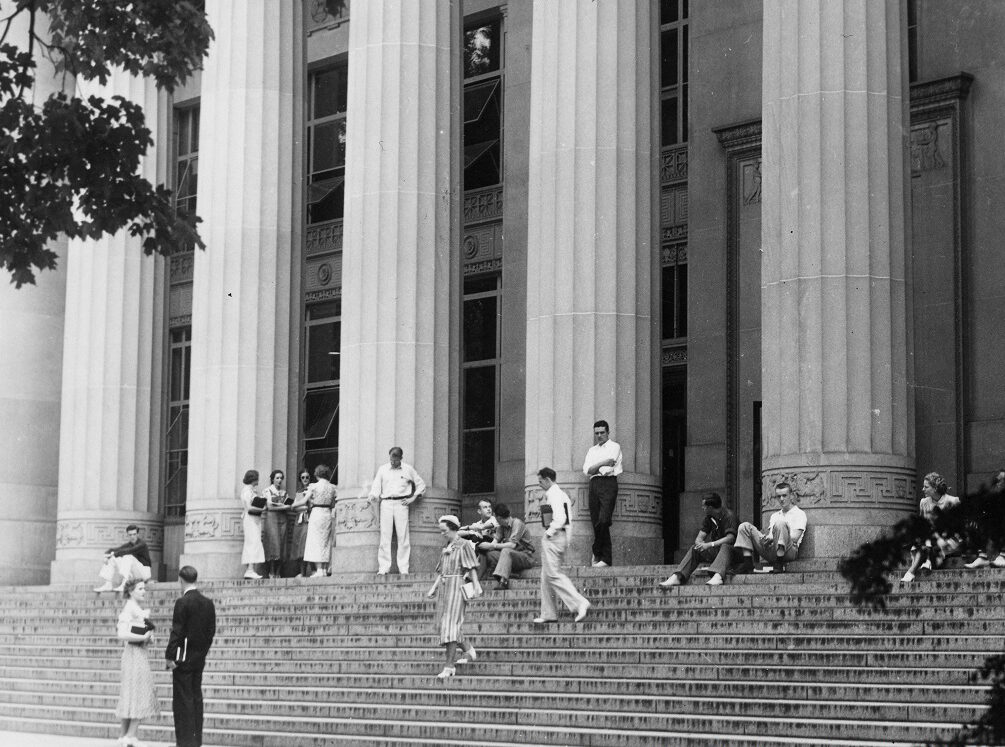Where Michigan’s
History Lives
Begin your research
Use the U-M Library Search to explore the Bentley's collections.
Hours and Location
Hours:
Monday: 10:00 AM – 4:00 PM
Tuesday: 10:00 AM – 4:00 PM
Wednesday: 10:00 AM – 4:00 PM
Thursday: 10:00 AM – 4:00 PM
Friday: 10:00 AM – 4:00 PM
1150 Beal Avenue
Ann Arbor, MI 48109-2113 U.S.A.
734-764-3482

Featured Site
Beyond the Horizon

News
Strong as Steel

Stay Connected
Did you know that Nichols Arboretum was known as “the Glen,” over 110 years ago?
In 1907, the land that would become the Arb was titled "the Glen" by the parks department!
This likely referred to the old “Schoolgirls Glen,” a sloped, green space in the Arb that was historically known as a favorite flower-picking area for a local school. 🌸
You can still view the beauty of that glen today, as part of Nichols Arboretum!
Over the years, the Arb has expanded to include things like the W.E. Upjohn Peony Garden, and hosted theatrical performances, art installations, and more. ⭐
Today, the Arb is managed in combination with Matthaei Botanical Gardens, and several other spaces, preserving and celebrating nature with over 700 acres combined.
Click through to glimpse scenes from the Arb’s past, in honor of Arbor Day! 🌳
📸: Historic images sourced from the Vertical File Photographs, Harlow Olin Whittemore papers, and the Ivory Photographs
#NicholsArboretum #ArborDay #DidYouKnow #TheArb #FlashbackFriday #AnnArbor #Michigan #ParkHistory #CelebrateNature

Did you know that Nichols Arboretum was known as “the Glen,” over 110 years ago?
In 1907, the land that would become the Arb was titled "the Glen" by the parks department!
This likely referred to the old “Schoolgirls Glen,” a sloped, green space in the Arb that was historically known as a favorite flower-picking area for a local school. 🌸
You can still view the beauty of that glen today, as part of Nichols Arboretum!
Over the years, the Arb has expanded to include things like the W.E. Upjohn Peony Garden, and hosted theatrical performances, art installations, and more. ⭐
Today, the Arb is managed in combination with Matthaei Botanical Gardens, and several other spaces, preserving and celebrating nature with over 700 acres combined.
Click through to glimpse scenes from the Arb’s past, in honor of Arbor Day! 🌳
📸: Historic images sourced from the Vertical File Photographs, Harlow Olin Whittemore papers, and the Ivory Photographs
#NicholsArboretum #ArborDay #DidYouKnow #TheArb #FlashbackFriday #AnnArbor #Michigan #ParkHistory #CelebrateNature
...
Here’s what the Law Quad looked like under construction, on this day exactly 100 years ago! 🕜
Five fun facts about U-M’s Law Quad that you may not know:
🎓 Several Law Quad columns include carvings of former presidents of U-M!
🏒 Carved corbels on the Quad also show the four seasons as U-M sports: “winter” as a hockey player, “fall” as football, “spring” as baseball, and “summer” as tennis!
✨ William Cook, the alum who donated the original four buildings of the Law Quad, actually refused to see them in person, considering them a “dream” that he didn’t want to “spoil.”
⚖️ The Quad was home to the Army`s Judge Advocate General Corps (JAG) program in the 1940s, training lawyers for the army during World War II.
🪟 The Law Library reading room also includes stained glass windows featuring seals from law schools across the world!
You can learn more about the history of the Law Quad by diving into the Law School records, and books like “Giving it all away: the story of William W. Cook & his Michigan Law Quadrangle” by Margaret Leary, in the Bentley’s reading room!
📸: Law School records
#OTD #100YearsAgo #UMich #AnnArbor #LawQuad #HistoricBuildings

Here’s what the Law Quad looked like under construction, on this day exactly 100 years ago! 🕜
Five fun facts about U-M’s Law Quad that you may not know:
🎓 Several Law Quad columns include carvings of former presidents of U-M!
🏒 Carved corbels on the Quad also show the four seasons as U-M sports: “winter” as a hockey player, “fall” as football, “spring” as baseball, and “summer” as tennis!
✨ William Cook, the alum who donated the original four buildings of the Law Quad, actually refused to see them in person, considering them a “dream” that he didn’t want to “spoil.”
⚖️ The Quad was home to the Army`s Judge Advocate General Corps (JAG) program in the 1940s, training lawyers for the army during World War II.
🪟 The Law Library reading room also includes stained glass windows featuring seals from law schools across the world!
You can learn more about the history of the Law Quad by diving into the Law School records, and books like “Giving it all away: the story of William W. Cook & his Michigan Law Quadrangle” by Margaret Leary, in the Bentley’s reading room!
📸: Law School records
#OTD #100YearsAgo #UMich #AnnArbor #LawQuad #HistoricBuildings
...
Whether you’re looking for historic photos of squirrels, or your dad’s old yearbook, we’re here to help! ⭐️
Did you know that the Bentley Historical Library is free and open to the public? That means:
🏀 U-M sports fans
✏️ Writers of historic fiction looking for story ideas
🌳 People interested in family history
😊 You, and your mom who’s in town for commencement
🔎 Or anybody who’s just plain curious
…Are all welcome in the Reading Room! (Yes, even if they’re not students!)
Come visit the Bentley on U-M’s North Campus in Ann Arbor, and unbox historic letters, leaf through scrapbooks, watch digitized football films, and more, Monday through Friday, 10 AM to 4 PM. ✉️📖🏈✨
We are so excited to help you find what you’re searching for!
📸: Cardboard cutout of historic U-M women’s basketball players in the Bentley Historical Library’s stacks
#MichiganHistory #UMich #BentleyHistoricalLibrary #Archives #LibrariesAreAwesome #AnnArbor #DidYouKnow #ThingsToDoInAnnArbor

Whether you’re looking for historic photos of squirrels, or your dad’s old yearbook, we’re here to help! ⭐️
Did you know that the Bentley Historical Library is free and open to the public? That means:
🏀 U-M sports fans
✏️ Writers of historic fiction looking for story ideas
🌳 People interested in family history
😊 You, and your mom who’s in town for commencement
🔎 Or anybody who’s just plain curious
…Are all welcome in the Reading Room! (Yes, even if they’re not students!)
Come visit the Bentley on U-M’s North Campus in Ann Arbor, and unbox historic letters, leaf through scrapbooks, watch digitized football films, and more, Monday through Friday, 10 AM to 4 PM. ✉️📖🏈✨
We are so excited to help you find what you’re searching for!
📸: Cardboard cutout of historic U-M women’s basketball players in the Bentley Historical Library’s stacks
#MichiganHistory #UMich #BentleyHistoricalLibrary #Archives #LibrariesAreAwesome #AnnArbor #DidYouKnow #ThingsToDoInAnnArbor
...
Can you guess where this picture was taken? 🗽
⭐ If you guessed Detroit, you’re right!
Throwback to 1918, when this 60-foot-tall plaster replica of the Statue of Liberty was brought to Cadillac Square as part of a push for Liberty Bonds during World War I!
According to the Detroit Free Press, “elaborate plans” were made for “nightly pageants” around the statue, as the government tried to convince citizens to buy Liberty Bonds.
The “official yell-master and pep man” for Detroit’s Liberty Bonds was U-M alum J. Fred Lawton, who led Detroit crowds in singing “campaign songs” around this statue with his megaphone. 📣🎵
You can find more photos of historic Detroit Liberty Bond rallies like these in the George W. Merrill photographs, and in the J. Fred Lawton papers.
#TBT #Detroit #WorldWarI #CadillacSquare #StatueOfLiberty #LibertyBonds #MichiganHistory #DetroitHistory

Can you guess where this picture was taken? 🗽
⭐ If you guessed Detroit, you’re right!
Throwback to 1918, when this 60-foot-tall plaster replica of the Statue of Liberty was brought to Cadillac Square as part of a push for Liberty Bonds during World War I!
According to the Detroit Free Press, “elaborate plans” were made for “nightly pageants” around the statue, as the government tried to convince citizens to buy Liberty Bonds.
The “official yell-master and pep man” for Detroit’s Liberty Bonds was U-M alum J. Fred Lawton, who led Detroit crowds in singing “campaign songs” around this statue with his megaphone. 📣🎵
You can find more photos of historic Detroit Liberty Bond rallies like these in the George W. Merrill photographs, and in the J. Fred Lawton papers.
#TBT #Detroit #WorldWarI #CadillacSquare #StatueOfLiberty #LibertyBonds #MichiganHistory #DetroitHistory
...
Hours and Location
Hours:
Monday: 10:00 AM – 4:00 PM
Tuesday: 10:00 AM – 4:00 PM
Wednesday: 10:00 AM – 4:00 PM
Thursday: 10:00 AM – 4:00 PM
Friday: 10:00 AM – 4:00 PM
1150 Beal Avenue
Ann Arbor, MI 48109-2113 U.S.A.
734-764-3482

